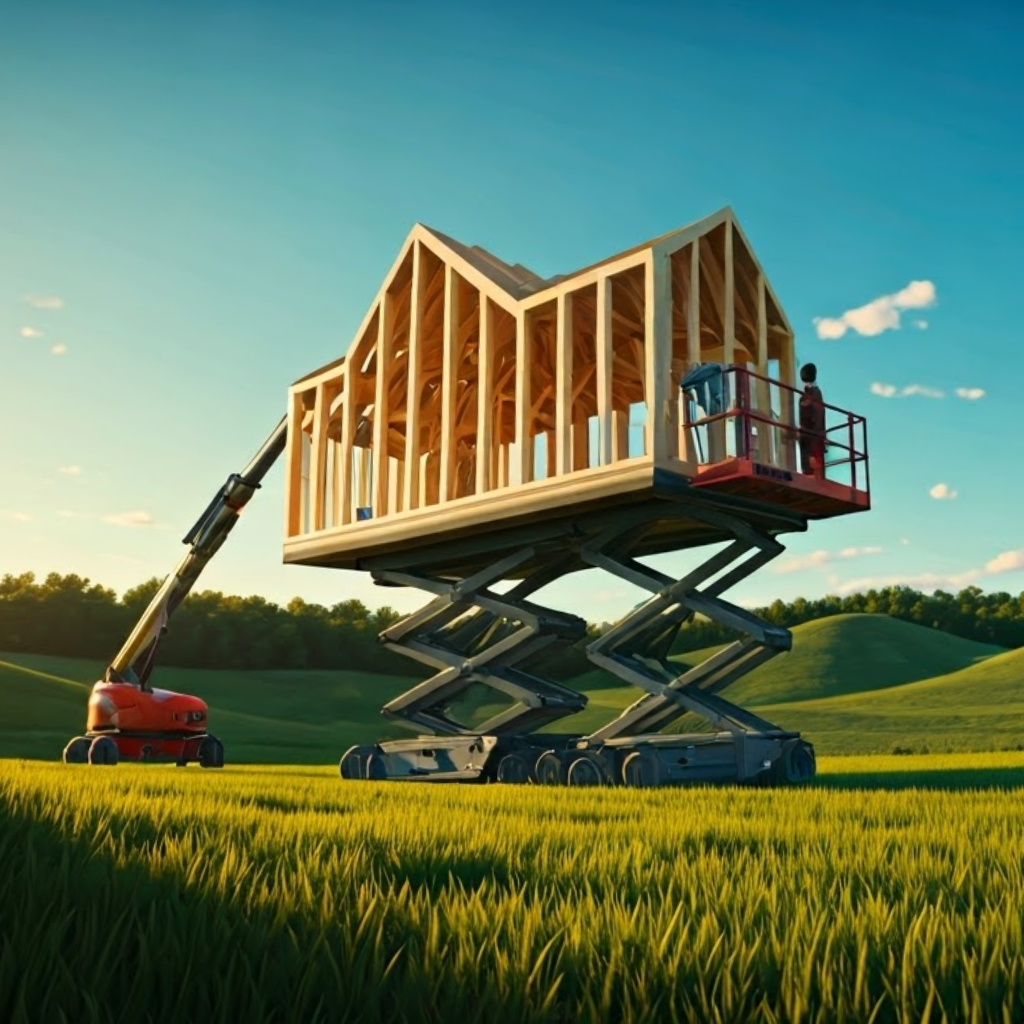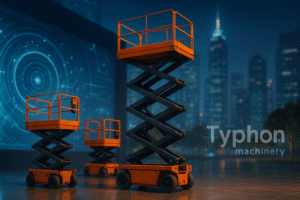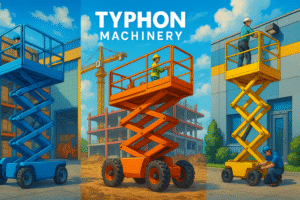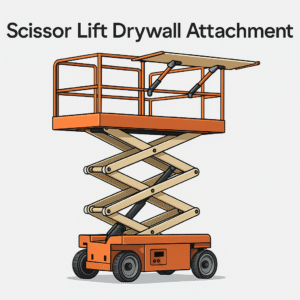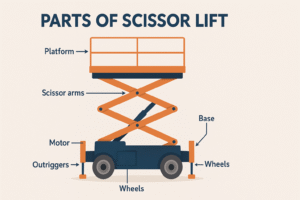Boom lift operation on slopes and uneven terrain requires precision, knowledge, and safety at all times. Whether you are an aerial equipment expert or a newbie, slopes provide distinct challenges that need extra thought.
And most crucial? To safely operate boom lifts on slopes, we must first realize that even a minor incline may affect stability and driveability.
Using the equipment on tough terrain requires the 10 safety precautions in this article. You’ll learn about the crucial differences between a task well done and a risky one, from equipment selection and stability to emergency measures.
This is the area to develop your slope operating skills and maintain job safety. We’ll examine the essential safety guidelines to assist you navigate tough terrain safely.
Key Takeaways:
- Proper equipment selection is vital – choose between telescopic boom lifts and scissor lifts based on terrain conditions and work requirements
- Understanding slope limitations and maximum angles is essential for preventing lift accidents and maintaining stability
- OSHA-compliant safety training and proper operator certification are fundamental requirements before attempting slope operations
Regular safety checks and equipment inspections are an important part of the operation, especially focusing on the hydraulic cylinder and stabilization systems.
Proper preparation of the workspace and the safety measures that are enforced, including but not limited to identifying the possible dangers and installing the safe working angles, are indispensable.
Understanding the Slopes and Terrain Challenges
To begin with, the handling of the lifting of the platforms requires that the operators are knowledgeable of different ground situations they can face. The changing of terrains results in a different new set of challenges that could impact your machinery’s stability and safety.
Kinds of Unfavorable Terrains
By using the boom lift, essentially, you will be obliged to negotiate through a wide range of terrain types each of which requires delicate handling. For example, on a steeper slope, the center of mass of the machine moves a lot, so an operator has to be super careful, and also the rises can vary from a small one to a steep one that a machine can barely manage.
Another difficult area is the one with the sloping ground. Here, the ground is no longer flat but can have holes and protrusions, like the incident of varying degrees, the latter that not only an analysis and survey should solve before the machine operates.
Some examples of life tested dangerous terrains include:
- Construction sites where soil elevations are repeatedly clay based
- Natural hillsides or escarpments
- Grading surfaces of different degrees of slope
- Rocky or debris-filled land
- No extra privacy for you
- Mud patches or loamy soil conditions
- Terrain areas that are a mix of surfaces
Recognizing these changes in the landscape can help you decide on the proper positioning of your equipment and operational strategies. Each type of surface will require certain preparations and safety measures to ensure the stable operation of the boom lift.
💡 Key Takeaway: Different terrain types demand an intense scrutiny process ranging from steep slopes to uneven grounds, and the related safety measures are a must to prevent accidents and ensure a stable boom lift operation.
Safety Assessment Before Commencing Operation
Site Online Protocol
To ensure seamless operations with a boom lift on slopes, do a thorough site study as the first step. To begin, check the workplace for potential risks such as overhanging power wires, obstructions, or concealed surface flaws.
Identify soil type, compaction, evidence of recent digging, underground utilities, and drainage systems that may impact stability. Rapid terrain changes are of special relevance since they might pose a danger.
To guarantee safety during boom lift operation, document any interfering obstructions and dangers and their source. This includes determining slope angles using an inclinometer within manufacturer restrictions, ensuring correct earthing and insulation.
Weather and Other Environmental Factors
When using a big equipment like a boom lift on slopes, weather conditions significantly impact safety. Before starting work, assess the surroundings for weight and visibility conditions, in addition to safety testing.
Remember that the boom lift is exposed to the full force of wind, which significantly affects it. The lift is vulnerable to wind power, including the whole extension, making it a significant concern in severe winds. Hence, check wind conditions before utilizing the elevator and every two hours while in the market to account for weather changes.
Periodically check the wind-meter to gauge wind speed. Additionally, prepare for emergencies by equipping operators and setup unit with an emergency stop device. Stop work immediately in bad weather, then run the lift down until the weather improves.
Rain, snow, or ice, Low friction and slick weather conditions dramatically enhance the risk of sliding. Facilitate appropriate drainage towards the sewer line to prevent water accumulation and ground instability in the workplace.
The visibility level during an operation is also important to consider. Insufficient light may impair visibility or produce misjudgments of distance.
Plan your job to minimize low visibility by operating during strong sunlight. Additionally, artificial lighting is important for poor visibility situations.
Extreme temperatures have the greatest influence on equipment operation and operator comfort. Check weather forecasts and avoid scheduling activities during unexpected weather to maintain safe work practices.
💡 Key Takeaway: A thorough ground reconnaissance performed as part of an offsite pre-operation inspection of weather and site, is the most important safety crusher in regard to not only efficient but also risk-aware operation during lift work.
Choosing the Right Equipment
Equipment Specifications and Limitations
For the stable and risk-free working process in hilly and rough ground, the correct aerial work platform Telescopic boom lifts are highly reasonable in comparison to scissors lifts by providing the best outreach and flexibility in hard-to-reach locations. Usually, these machines have a higher ground level and a better stability system, making them the best choice for use on the slopes of land.
Before you begin to recognize the device, check some of the most important specifications in detail:
- The maximum ratings for the incline.
- The capacity of the platform when it is inclined.
- The height you can reach and the distance you can operate without losing contact.
- The configuration of the outriggers.
- Data on the pressure on the ground.
- The system of tires or tracks.
It is necessary to find a boom lift that suits your unique terrain issues. For example, tracked boom lifts are especially stable and have better traction on rough or muddy surfaces than the wheeled ones.
If you are comparing between some types of aerial work platforms, these are the limitations you might face:
- Scissor lifts might have gradient restrictions more strict than those of boom lifts.
- A fraction of telescopic boom lifts will be of reduced loading capacity due to their incline operation
- In the presence of instability on the floor, the size of the platform and the weight limit are to be taken care of more.
- Other conditions may still affect the capabilities of the equipment.
It should be clear that the main role of the manufacturer’s standards sheets is just to provide you with the limits and that obeying the regulations of these super limits is a must.
Always read your machine’s user manual and safety instructions to verify if the machine is fit for the slope factor of your working place. This time-consuming process of picking the correct machine model from the aerial work platforms available has the following benefits: no accidents and the realization of an efficient project.
💡 Key Takeaway: Check the specifications of a lift selected for the tasks at your location and also understand its limits in detail, as well as always follow the manufacturer’s recommendations for safety during slope work.
Proper Stabilization Techniques
When the slopes are a must, a lot of stabilization is needed to keep the challenge safe and secure. Examination of the ground in the first run is a must so that only the proper and reported means of stabilization can be adopted to avoid any kind of accident.
Using Outriggers and Leveling Systems
An auto-leveling boom lift with outriggers provides vertical stability in bad weather. Outriggers should be completely extended and on solid ground before usage. Intelligent hydraulic cylinder technology levels a low-balance boom.
To distribute the weight evenly and prevent the machine from sinking, particularly on soft or unstable terrain, an outrigger pad must be placed beneath each stabilizer. The independent axle design optimizes outrigger ground contact and machine weight distribution. This ensures lift stability and weight balance.
Stabilizing the working machine neatly requires monitoring its level indicators during the process. Many elevators include sensors that alert workers about over-angling hazard. If the location is too severe, operators might use:
- Ground protection mats
- Steel plates
- Temporary surfaces that are engineered
- Cribbing blocks made of wood
Do not forget to:
- Regularly inspect the placement of outriggers
- Keep at least the minimum safe distances from the edges
- As the ground conditions change, adjust the stabilization
- Do not at any time exceed the slope ratings given by the manufacturer of the aerial boom lift
💡 Key Takeaway: Proper stabilization through outriggers, leveling systems, and appropriate ground support is crucial for safe boom lift operation on slopes, with continuous monitoring of equipment levelness throughout the task.
Safe Operating Procedures
Movement and Position Control
When operating a boom lift on slopes, accurate movement and positioning control are crucial for safety and stability. Maintain the proper operating angle on uneven terrain to avoid accidents and equipment damage.
Start by gently maneuvering the boom lift on the hill at a reduced speed for better operations and to respond to stability issues. Avoid leaving the controls or making rapid moves that might cause equipment tipping.
Avoid areas with significant dangers such as drop-offs, holes, or debris that might compromise the lift’s stability. To minimize tipping, place the boom lift over the slope to distribute weight evenly.
- Be careful in moving the boom position
- Perform the movements one by one
- Keep the movements at a slow pace and do them on purpose
- Keep an eye on the platform level gauge at all times
- Extend the boom only as far as absolutely necessary
- Observe the safety rules of the manufacturer’s about the allowed load capacity
It is always best to stay mindful of several other factors such as the terrain’s condition. It is important to note that wet, muddy, or loose ground can lead to reduced traction of the machine and it may also cause instability. If the terrain is in doubt, stop working and check again before you proceed to get a precise location:
- The boom controls must be used smoothly and incrementally
- Try to keep the platform low to the ground while moving
- Continuously look out for obstacles above your head
- Confirm that there are no obstacles around you before you rotate
- If the machine has outriggers, ensure they are well installed
It is important to remember that wind can negatively affect safety at height, and especially when operating a boom lift. Keep a real time track on weather changes and adjust work correspondingly, strictly adhere to extra precautions if winds are picking up.
💡 Key Takeaway: Control the actions of the boom lift with gentle, slow movements while constantly monitoring the tilt angle, terrain and surrounding hazards so that the vehicle is handled properly even on rough surfaces.
Emergency Response Protocols
Recovery Procedures
With the boom lifted on slopes, emergency planning is essential. Any lift issue doubles on the hill, therefore it’s crucial to have and keep clear. Emergency circumstances come unexpectedly, leaving the operating crew limited space for action and high accident rates.
All activities should be stopped if instability or risk is detected. If safe, lower the platform gently and gradually. Avoid rapid movements that might destabilize. When the lift slips, operators must:
- Grab the guardrails tightly
- Remain on the platform
- Alert the ground team instantly
- Abstain from sudden movements or shifts of weight
- Wait for emergency response team if needed
An auto-leveling boom lift with outriggers provides vertical stability in bad weather. Outriggers should be completely extended and on solid ground before usage. Intelligent hydraulic cylinder technology levels a low-balance boom.
To distribute the weight evenly and prevent the machine from sinking, particularly on soft or unstable terrain, an outrigger pad must be placed beneath each stabilizer. The independent axle design optimizes outrigger ground contact and machine weight distribution. This ensures lift stability and weight balance.
Stabilizing the working machine neatly requires monitoring its level indicators during the process. Many elevators include sensors that alert workers about over-angling hazard. If the location is too severe, operators might use:
💡 Key Takeaway: To reduce the risk of operator injuries during the recovery process, well-defined emergency protocols should be set up and regular drills should be conducted during boom lift accidents that happen on slopes.
Operator Training Requirements
When the work requires the use of boom lifts on slopes, the workers must be adequately trained and possess the necessary skills that will allow them to navigate such terrain safely. A good training course ensures the operators get versed with the knowledge and skills that can help them operate in each working environment properly and still maintain the right safety practices.
Certification and Compliance
One of the most indispensable elements for the efficient operation of an aerial work platform on slopes and rough surfaces is safety training. An OSHA-compliant safety training program has a number of elements that are highly important in order for the program to be effective:
- Slope trial
- The point of no return of the steepness
- Ways to start up an emergency response
- Using equipment checklists
- Knowing weather predictions
- Making a ground condition report
While everything is going well, there is no inclination of any necessity for training until operators start to face the real challenges of the world. Certified operators are among those who are fitted out best to:
- Pay attention to possible dangers
- Be capable of deciding about the place of the equipment
- Use the systems of stabilizers in the correct way
- Always communicate properly with the ground crew
- Nobody is around when we need to, quickly execute the emergency Procedure
Most effective training programs combine hands-on learning with conventional classroom teaching. The combination lets operators understand and apply theoretical concepts. To comply with new safety features and equipment, training material must be updated regularly.
OSHA mandates that boom lift operators must receive formal training before working on sloped surfaces. This inclusive approach includes these areas:
- Training according to the specific boom lift equipment
- Recognition of workplace hazards
- Load capacity calculations
- The method of determining stability
- Performance of the emergency response procedures
💡 Key Takeaways: Competent operator training, inclusive of OSHA-approved certification, forms the good and secure foundation for the slope work of these power
Regular Maintenance and Inspections
It’s not that only the regulations call for you to keep your boom lift in perfect condition – it’s just that the latter allows you to avoid being strapped for time, prevents expensive breakdowns and common used on slopes, thus ensuring the safe operation of people, as well as the machine. There is a huge interest ‘for’ regular inspections and maintenance checks not only in, but also in the industrial and construction sectors where the usage of the machine is a must.
Pre-use Checks
Prior to moving the boom lift over uneven terrain, do thorough pre-use inspections. Start your inspection by checking the tires for proper pressure and condition, since they are the most crucial component of the stability chain. Ensure all hydraulic systems work smoothly since they are crucial for a successful task completion.
Check outriggers and stabilizers for wear or damage. All control activities, including emergency and tilt sensors, must be tested at this stage. In particular, the braking mechanism is essential for maintaining control on slopes.
Remember to check that all safety equipment and warning systems are working properly. Ensure the level indicators, load sensors, and emergency stop button are properly functioning. Record all checks in a specific maintenance journal. The approach lets you track machine health over time.
💡 Key Takeaway: Frequent inspections of the machinery and conducting thorough pre-use checks are conditions that need to be fulfilled, besides, to make the safe use of the slope white-extremely unlikely if not impossible, and to provide the most efficient trouble-free performance for the work on the rough terrain, boom lifts are the best option.
Conclusion
Operating boom lifts on slopes and tough terrain needs skill, experience, and safety. Operators may dramatically decrease dangers in atypical work contexts with following 10 tips. Remember that proper training, site appraisal, and equipment selection avoid accidents and save lives.
Safety standards and awareness may make a big difference on construction and industrial sites. To successfully handle difficult circumstances, check equipment, comprehend load limits, and maintain manufacturer-specified grade.
Maintain slope-specific criteria and emphasize monitoring and preparedness. Detail these practices, considering the training industry, and prioritize colleague health and safety as the first step to success. Putting safety and productivity first will make the workplace safer and more productive.
FAQs
What’s the most undisturbed grade angle playing safely with a stick machine?
A maximum safe slope angle is usually 2.5 to 5 degrees, depending on the brand and model of the telescopic lift. Refer to the user’s manual of the machine for the exact specifications and always stay within the specified slope limits of your particular piece of equipment.
How frequently are we supposed to sign boom lift operators up for safety training for slope operations?
Normally, operators must undergo full safety training every year, and those who work on the sloping region most of the time must also take a half-yearly refresher course. OSHA standardized safety training could also mean training that is focused on operating on uneven terrain and procedure to be followed in case of an emergency.
Are the weather conditions of any influence for the stability of the boom lift on the slope?
It definitely is so. The weather has a big influence on the performance of a boom lift on a slope. The slipperiness can be caused by rain, the wind can seriously affect the balance and even the oil in the system may react differently at extreme temperatures. Therefore, if the weather is to change, one must look at the weather forecast and then decide on the operation thereafter.
How do the two types of lifts differ in their operation on a slope, say, a boom lift and a scissor lift?
With the design of a boom lift, there are a better flexibility and reach on slopes that make it the ideal choice for the job. The telescopic boom is the reason behind the extended reach, and its independent axles ensure greater flexibility and adaption to the uneven terrain. In contrast, due to the limited slope capabilities of scissor lifts, it is best to avoid using them on significant slopes even if they are quite stable on flat surfaces.
How do self-leveling boom lifts work on uneven terrain?
Boom lifts with self-leveling capabilities utilize hydraulic cylinders that incorporate sensors and automatic systems to align the platform position with the ground. They are able to read and correct the position of the machine constantly, ensuring its stable state on an uneven surface.
If a disaster strikes and a boom lift starts to tip on a slope, what are the proper steps the operators need to take?
When the boom lift is about to tip over, the operators have to lower the boom and retract the extension immediately and then steer clear of any abrupt or sudden motions. It is important to keep the upper operating device reachable, continue to communicate via radio with the ground crew, and abandon the platform only if it is safe to do so.

